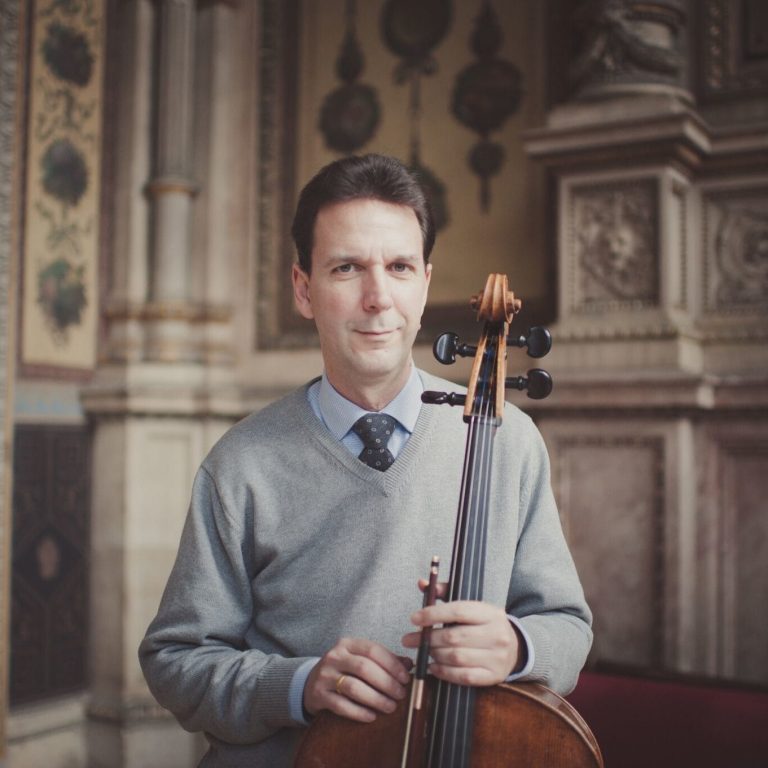Tamás Varga Guest Stars With Frankly Music
Renowned principal cellist with Vienna Philharmonic featured in Bach, Reger and Brahms.
Frankly Music, founded by former Milwaukee Symphony Orchestra concertmaster Frank Almond, continues a 20th anniversary year inviting friends from Chicago, New York, and Vienna for a varied evening of chamber music this Saturday evening, March 16.
Tamás Varga, principal cellist with the Vienna Philharmonic, will take time out from a United States tour by the Vienna Philharmonic. Often chamber music ensemble works expose but do not highlight the talents of individual members. Varga will be featured in two solo works to recognize his reputation as a great cellist.
Recognizing his championing of modern composers, the program also includes Varga playing the Sonata for Solo Cello (1955) by American composer George Crumb. Crumb is perhaps best known for Black Angels, a startlingly contemporary string quartet for amplified instruments. This cello sonata is more contemplative, exploring the resonant acoustic capabilities of the instrument.
Toby Appel will join Almond and Varga for a string trio. A long-time viola faculty member of the Julliard School, Appel also performs and teaches in Santa Fe. Almond has known Appel for years. “Toby’s a very, very interesting person. (Aside from his music) he also happens to be a world-class chef who once ran a restaurant in Santa Fe and was once house chef for Georgia O’Keefe.” Appel has participated in the summer chamber music program Almond directs at Milwaukee Youth Symphony Orchestra.
A string trio can be challenging for string players. Almond observes that “the sonority and the color and timbres of different sounds are very different than when you have an extra violin. You are more exposed.”
The third guest, pianist Victor Santiago Asunción serves as Artistic Director and Founder of the Evanston Chamber Music Society, and Chamber Music @Lauderdale by the Sea. His recordings are often of chamber music, frequently performing as a concert pianist or recitalist. Asunción appears with Almond in the 3rd volume of three-disk recording of “A Violin’s Life” — inspired by the back story of Almond’s well-traveled (and once stolen) Stradivarius violin.
The opening movement features brooding, ominous nearly violent music. A driving scherzo in the second movement continues the drama. An extraordinary third movement Adagio may reflect Brahms’ thoughts of Clara centered on a cello intermezzo and duet with the first violin creating what critic Kai Christiansen called “an exquisite duet with Brahms’ characteristic harmonies in 3rds and 6ths warmly supporting two lovers rapt with song.” The finale mixes lyrical passages with a restless, driving energy that Christensen suggests “presents a magical transformation of texture, color, and mood that keeps you hanging until the very last, unexpected note.”
Saturday’s concert will begin at 7:00 p.m. at the Milwaukee Youth Arts Center, at 325 W. Walnut St. near downtown Milwaukee. Tickets may be purchased online or at the door.
The fifth and final concert for this season, String Theory, at Wisconsin Lutheran College on May 6 will feature string sextets and a quintet. The program will include the sublime Capriccio by Richard Strauss, Arnold Schoenberg’s gorgeous (and dramatic) Transfigured Night and the rousing String Quintet in G by Brahms.
If you think stories like this are important, become a member of Urban Milwaukee and help support real, independent journalism. Plus you get some cool added benefits.
Preview
-
A Sacred Choir, 70 Voices Strong
 Dec 14th, 2025 by Martha Brown
Dec 14th, 2025 by Martha Brown
-
Prometheus Trio Goes Bohemian
 Dec 3rd, 2025 by Martha Brown
Dec 3rd, 2025 by Martha Brown
-
Present Music Offers New Choral Works
 Nov 20th, 2025 by Michael Barndt
Nov 20th, 2025 by Michael Barndt


















